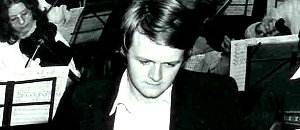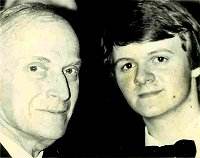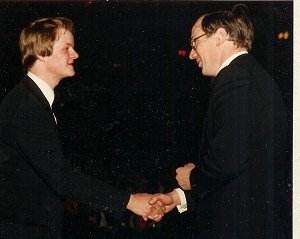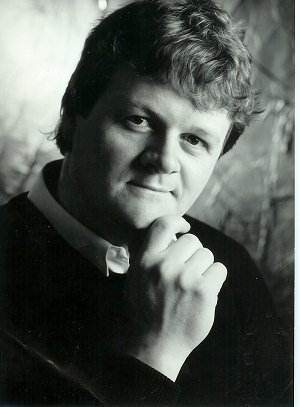Born in 1956, Adrian Williamsís musical talents manifested themselves at an early age, initially as a gifted pianist but followed very quickly by serious attempts at composition. Gaining a reputation as a child prodigy at the piano, his earliest compositions (now withdrawn) flowed from around the age of eleven and include a Piano Trio in G Minor dating from 1967. This was followed in 1968 by a Symphony in D Minor together with a String Quartet and Clarinet Trio of the same year.
Consultations with Lennox Berkeley ensued from the age of thirteen, by which time he was already giving piano recitals on a regular basis. Enrolment at the Royal College of Music led to piano studies with John Lill and John Russell, whilst composition studies were under the tutelage of Bernard Stevens and Alan Ridout. It was during this period of study at the RCM that his music first started to attract serious attention.
The productive years around his late teens and early twenties spawned such works as the ambitious and assured Symphonic Studies, his first mature orchestral work. Also from this time comes the substantial Sonata for solo cello of 1977, now recorded by Raphael Wallfisch on the Metronome label along with two other major works for the instrument, Spring Requiem (1993) and Images of a Mind (1986). Although stemming from the early years of his career these works already demonstrate the essential characteristics of Williamsís compositional hand. These include a deep melodic vein that runs through his entire output, even amongst those later compositions that exhibit a grittier melodic and harmonic palette. This is coupled with a strong and audible formal command capable of binding together conceptions on the most substantial scale, the aforementioned Sonata for solo cello and the Second String Quartet being prime examples. This latter work is a particular tour de force, a massive single span of around thirty-eight minutes. This essential lyricism and accessibility remains vital to the composer to this day, "That my music should affect people concerns me. I write for a public. I am not an isolationist".
It was whilst still a student at the RCM that Williams celebrated his first major success, winning the Yehudi Menuhin composition prize for his work Explorations and Metamorphosis. The great man himself was later quoted describing the composer as "a master of intricate patterns and forms". Also whilst still a student his skill as an arranger and orchestrator was noticed. As a result he became closely involved with arranger and conductor Peter Knight, scoring a number of films and TV advertisements before a similar relationship commenced with Carl Davis. Arrangements still form an active part of his musical life with recent additions to the catalogue including an arrangement for small orchestra of My Heart Will Go on, the theme from James Hornerís score for the film, Titanic.
Throughout this period the piano was still an important part of Williamsís day to day life (the composer can be heard as pianist accompanying Raphael Wallfisch on the Metronome disc of cello music). An increasing reputation for virtuoso improvisation in recitals, led to considerable acclaim from his audiences, a skill with which he can still amaze today, albeit perhaps with some reluctance.
With the Duke of Gloucester 1980The years following college studies saw a period as composer in residence at Charterhouse School from 1980-1982. These were unhappy yet fertile and crucial years for Williams as they followed something of a stylistic and creative crisis. His time at Charterhouse saw a consequent re-evaluation of his compositional language but also brought its share of success with a number of the works written around this period still being felt by the composer to be amongst his finest. These are the Second String Quartet, the first set of Five Songs of W.H. Davies, Horseman, Pass By for piano, Where Chimneys Fall for oboe and in 1982 the symphonic poem, Tess. I shall speak more of the stylistic changes that Tess in particular heralded later. Equally crucial during the period at Charterhouse was Williamsís new-found discovery of Christianity, an absorption that has since waned but resulted in a steady flow of works for the church over a period of a decade.
The changes in musical language may also have contributed to a major change in life, for in 1982 Williams left Charterhouse, bringing to an end the misery of his tenure there. He then moved to the Welsh borders, a momentous decision for Wales was to become a spiritual home for the composer. More than this it also became an outlet for expanding wider horizons in the founding of the Presteigne Festival, an annual musical feast that Williams was to organise and manage for the next ten years until he eventually moved back to London. As the composer explains below, the festival gave him a platform for his own music. Not only this but it also presented an opportunity to explore the music of other composers that meant much to him, all in the glorious surroundings of the Welsh countryside and of St. Andrews Church in Presteigne, a sanctuary of considerable importance to Williams. As a result there was a continued resurgence of his creative flow with one notable work from 1985, Behold, how good and joyful, for chorus and orchestra, winning him the Guinness Composition Prize. More significant however was the resultant commission, Not Yet Born, a major setting of MacNeice for chorus and orchestra. The composer considers this to be far more important than the original prize-winning work. Sadly the premiere of Not Yet Born was not a success, suffering from poor preparation and it still awaits a further performance. There continued to be much music for the church and in 1986, Images of a Mind, the work for cello and piano that was to lend its title to the aforementioned Metronome disc. 1987 and 1988 saw the orchestral works Leaves from the Lost Book and Dies Irae, the latter a major commission for the BBC Welsh Symphony Orchestra and one of the composerís most deeply felt orchestral creations.
The ten years since Williams left Wales and the Presteigne Festival have, at a number of levels, been difficult once again for the composer. The move to London proved to be an unhappy one. In 1994 Williams returned to Wales for a further five years before, in 1999, taking the decision to make a new life for himself in Japan, the home of his new wife. It seems however that Wales is never far from Williamsís mind. The last three years have seen several trips back to the UK with the eventual intention of settling once again in the borders with his wife and young son. Inevitably there have been spells, notably during the years in Japan, when the unsettling nature of losing his spiritual and home roots have impacted on his compositional output. Indeed, as if to prove his spiritual attachment to Wales, his second period in the borders had seen a number of crucial works written. Amongst them are Aruga, for chamber ensemble of 1996, the Chamber Concerto and Migrations for string orchestra, both from 1998. Although unintentional at the time, Migrations was to prove prophetic in its unconscious farewell to Wales prior to the composerís residency in Japan. Latterly 2002 has seen a fresh period of rejuvenation in Williamsís output with the completion of a commission for the Cheltenham Festival, Out in the Jungle, for six voices a capella. This was performed to considerable acclaim at the festival by I Fagiolini, coupled with the chamber work, Jizo, written for and now recorded by the Belgian ensemble, New Art Trio.
At this point it is crucial to put the foregoing factors into perspective by taking a look at the essential characteristics of the music itself.
To gain a true understanding of Williams and his work we must first understand something of the stylistic issues that have been constant throughout his compositional career. From even the earliest works there have always been two sides to his creative personality. The first is the essentially tonal and unashamedly melodic vein evident in such works as the Quatre Cantilènes. Set this alongside the grittier, harmonically more astringent language that inhabits the Symphonic Studies. This quality has been more prevalent since the symphonic poem, Tess, one of the crucial works that was written in 1982 following his period at Charterhouse. Indeed, there is no doubt that this stylistic "conflict" has inhibited Williamsís career in terms of the irregular flow of major commissions and his resultant public profile. He is seen by some as a composer who falls between two stools, an eclectic with a unpredictable thread running through his creative output. The composer explains below how the interest stirred by a tape playing of his Symphonic Studies during a 1979 Society for the Promotion of New Music course resulted in an expectant audience for the forthcoming premiere of his substantial choral and orchestral work, Maiores Ignoti. The audience was to leave disappointed at the composerís return to a broadly tonal idiom. Williamsís own comment here is telling, feeling that his "side-stepping" of a "real harmonic voice had worked". The words "side-stepping" and "real" give a broad clue as to where he felt his stylistic allegiances lay at the time.
Either way, in the prevailing circumstances and with the weight of expectation upon him, it was inevitable that a crisis of confidence if not style would eventually follow. When it did it resulted in a period of soul searching that lasted for around two years. What emerged from this soul searching was a more personally self-assured and secure composer. In reality the stylistic variations still exist in his work. One has only to compare the Chamber Concerto with Migrations for example. The music has however rid itself of any signs of apparent awkwardness, instead demonstrating a clear desire to communicate in a manner that to the composer is entirely natural; the honest expression of creative instincts that are without question second nature.
The essential seeds of Williamsís language are evident in a number of works dating from as far back as his mid to late teens. The String Quartet No.1, written in 1972 when Williams was just sixteen, bears numerous unmistakable hallmarks of the composers who were influential upon him at the time, most obviously Vaughan Williams. The vein of lyricism and sense of thematic structure that pervade the music are characteristics that can provide a link to as apparently diverse a work as the Symphonic Studies. Only three years separate the First Quartet from Nine Pins, the work for piano duet that spawned the Symphonic Studies, yet the stylistic gulf could be thirty years. It is the figure nine that is crucial to Nine Pins and the Symphonic Studies, being based on a nine-note row and cast in nine sections. Despite the astringency of the harmonic sound world and the composerís claim that he had avoided a true harmonic voice he still finds it almost impossible to abandon an audible structure and the work hangs together with some success for an early work on this scale.
The three String Quartets are an interesting case for study in Williamsís output, standing roughly ten years apart from each other. The Quartet No. 2 was written in 1981 during the composerís period at Charterhouse and is an ambitious undertaking by any standards, cast in a single continuous span of around thirty-eight minutes. Williams lays his material before the listener during the opening couple of minutes, notably an intensely fervent cello melody that breaks through after around one and a half minutes. What follows is a tightly argued and constructed cycle that condenses and breaks the material down before a long, gradual ascent begins to rediscover the opening material and melody. Although cast in five movements, the Sonata for solo cello, of 1977, is a similarly bold achievement, coming in at around thirty-three minutes. It remains one of the composerís most remarkable and assured works given its composition during his student years. In both cases the composerís grip on his material and overall structure is highly impressive. In contrast to the second, the Quartet No. 3 (1991) takes a more traditional four movement format (the last two are played continuously). It is more conventionally melodic and lyrical than its predecessor in a way that at times recalls the quartets of the Welshman Daniel Jones and, notably in the deep first movement, JanŠček. In the final movement however it is Bartůk that seems to be in the background, a figure whose quartets have, I suspect, been a source of inspiration to Williams. Like Bartůk, Williamsís scoring for the quartet medium is rarely short of masterful.
In 1988, three years before Williams wrote the Quartet No. 3, a commission from the BBC Welsh Symphony Orchestra had resulted in the first performance of Dies Irae, the first major orchestral score Williams had written since the symphonic poem, Tess, of 1982. This is one of the composerís most personal creations and makes a powerful, distinctive and perhaps above all, thought-provoking impression on a first hearing. The inspiration was drawn from the composerís anger at manís destruction of the natural environment, an issue that is close to his heart and recurs in a number of other works including Aruga. This anger and sense of desolation is wrought to telling effect, Williams quoting but not over-emphasising the plainchant Dies Irae and leaving the listener with little doubt as to the chilling consequences of his message. Of all his orchestral works Dies Irae leaves a particularly dark but lasting presence, an impression not dissimilar to that of the first movement of the Sinfonia da Requiem by Benjamin Britten, a composer who Williams counts amongst his most influential exemplars.
The two years prior to his return to Wales in 1994 were sparse although one work from 1993 is certainly deserving of mention. Spring Requiem, for cello and piano, was written in response to the death of his first wifeís father in Belgrade during the Balkan crisis and is subtitled ďIn memoriam Aleksandar MiletićĒ. The work reflects something of the anger felt by the composer at both the futility of the war itself and the needlessness of his father-in-lawís death. It is also imbued with the atmosphere of the Serbian Orthodox funeral service, the peeling of bells, incense hanging heavy in the air, the spring blossom on the approach to the church and a final ray of hope as the music seems to ascend into heaven itself during the final section, In paradisum: Adagio, one of the composerís most simple yet poignantly beautiful creations. A previous work for the same combination, Images of a Mind, written in 1986, had already proved Williamsí affinity with the cello, as if this were needed after the remarkable achievement of the earlier Sonata for solo cello. Images of a Mind has its origins in a self-portrait by Sidney Nolan. Williams knew the artist well, Nolan being one of his close neighbours in the Welsh borders. The composer happened to visit him when the paint was hardly dry on the canvas. The composer describes the work as "a kind of rhapsody" and it is true that the piece is possibly less strictly structured than a good number of his other works. Instead it paints a perceptive portrait of a personality that emerges as complex and multi-faceted but with a humanity that seems to shine through. Nolan himself paid it the greatest compliment in saying that it "revealed secrets he would long remember".
The five years marking Williamsís second period in Wales from 1994 to 1999 were particularly productive. From this period come a number of important works that reflect a sea-change in the composerís self confidence. Amongst them are Aruga for flute, clarinet, harp and string quartet (1996), the Accordion Quintet of the following year, the Chamber Concerto for eleven players and Migrations for twenty-two solo strings, both of 1998. The first three of these works stand apart from Migrations in that although the sense of melodic journey and cohesive thematic structure are still in evidence there is also a certain terseness. This is at its most obvious in Aruga, an at times angry piece that has its background in the protests surrounding the construction of the Newbury by-pass, an issue that was receiving much media attention at the time. Equally striking is the extreme energy that the pieces generate; an energy that seems at times to approach the frenetic. It gives a sense of the composer hardly being able to get his material down on paper quickly enough. It can be no coincidence that this latent sense of inner energy emerges in his music at a time when the composer was back in his spiritual homeland, the sense of renewed vigour and enthusiasm coming through with clarity in the music. Migrations is very much the odd work out of this group. The composer mentions that there is possibly a passing influence of minimalism in the piece but the listener will find nothing to bring to mind the likes of Steve Reich or John Adams. Instead this is perhaps the most overtly lyrical of the pieces from the second period in Wales, having little in common with the Chamber Concerto and Aruga other than a strong and audible framework. Williams is masterful in his writing for the strings, with a deep lushness in the more impassioned passages that is almost redolent of Elgarís scoring in his Introduction and Allegro. It is a work that will, I suspect, always stand both forward and somewhat alone in Williamsís output; deeply personal and ultimately, profoundly moving.
At the end of February 2003 Adrian Williams returned to the UK from Japan with his wife and son to settle permanently in his beloved Welsh borders. He took up residence in a small village between Hereford and Hay-on-Wye. His previous return to Wales in 1994 had heralded one of the most productive periods of his career and it is to be hoped that being in his spiritual home once again will enable him to strike a similarly rich seam of inspiration. Despite the self-questioning that has often been present Adrian Williams is a composer with much to say and the undoubted technique to say it with emotional and expressive clarity. With a number of potential commissions in the pipeline, including a work for the Raphael Ensemble (Presteigne Festival 2003), coupled with the first emerging signs of a new orchestral work the future certainly appears encouraging.
The interview that follows was conducted shortly prior to his recent return to Wales.
© Christopher Thomas 2003
Further information on Adrian Williams and his music can be obtained from the composerís own website www.adrianwilliamsmusic.com



